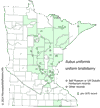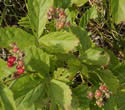Rubus uniformis (Uniform Bristleberry)
| Also known as: | Thornless Dewberry |
|---|---|
| Genus: | Rubus |
| Family: | Rosaceae (Rose) |
| Life cycle: | perennial woody |
| Origin: | native |
| Habitat: | part shade, sun; moist to dry soil; sedge meadows, swamps, marshes, prairies, forest clearings, open woods |
| Bloom season: | June - July |
| Plant height: | 1 to 2 feet |
| Wetland Indicator Status: | none |
| MN county distribution (click map to enlarge): |  |
| National distribution (click map to enlarge): |  |
Pick an image for a larger view. See the glossary for icon descriptions.
Detailed Information
Flower: 


![[photo of flower cluster]](/udata/r9ndp23q/trees/rubus-uniformis_0720_134826-t.jpg) A compact, flattish/convex cluster (corymb), often branching, at the tips of short lateral shoots along 1-year-old stems, each cluster with 3 to 11 flowers. Flowers are white, about 1 inch (2 to 3 cm) across with 5 rounded petals. In the center is a green cluster of many styles surrounded by a ring of numerous, creamy white-tipped stamens.
A compact, flattish/convex cluster (corymb), often branching, at the tips of short lateral shoots along 1-year-old stems, each cluster with 3 to 11 flowers. Flowers are white, about 1 inch (2 to 3 cm) across with 5 rounded petals. In the center is a green cluster of many styles surrounded by a ring of numerous, creamy white-tipped stamens.
![[close-up of sepals and flower stalk]](/udata/r9ndp23q/trees/rubus-uniformis_0616_131637-t.jpg) Cupping the flower are 5 green sepals, triangular with an elongated tip, the outer surface moderately to densely covered in non-glandular hairs. Flower stalks are short, densely hairy and may have scattered, slender prickles.
Cupping the flower are 5 green sepals, triangular with an elongated tip, the outer surface moderately to densely covered in non-glandular hairs. Flower stalks are short, densely hairy and may have scattered, slender prickles.
Leaves and stems: 


![[leaf scan]](/udata/r9ndp23q/trees/rubus-uniformis_0824_14243565-t.jpg) Leaves are alternate and palmately compound, both non-flowering first-year stems (primocanes) and flowering second-year stems (floricanes) with 3 leaflets; the lateral leaflets often have a single lobe on the lower half. Leaflets are sharply toothed around the edges, sparsely hairy to hairless on the upper surface, sparsely to moderately hairy on the lower, not velvety. The terminal leaflet on primocanes is 2½ to 3¾ inches (6.5 to 9.5 cm) long, up to about 2 inches (3.5 to 6 cm) wide, widest at or above the middle, rounded to wedge-shaped at the base, tapering to a short extension at the tip.
Leaves are alternate and palmately compound, both non-flowering first-year stems (primocanes) and flowering second-year stems (floricanes) with 3 leaflets; the lateral leaflets often have a single lobe on the lower half. Leaflets are sharply toothed around the edges, sparsely hairy to hairless on the upper surface, sparsely to moderately hairy on the lower, not velvety. The terminal leaflet on primocanes is 2½ to 3¾ inches (6.5 to 9.5 cm) long, up to about 2 inches (3.5 to 6 cm) wide, widest at or above the middle, rounded to wedge-shaped at the base, tapering to a short extension at the tip.
![[close-up of leaflet stalk]](/udata/r9ndp23q/trees/rubus-uniformis_0717_104603-t.jpg) Leaflet stalks are covered in non-glandular hairs and scattered slender, declined prickles. At the base of the compound leaf stalk is a pair of appendages (stipules), lance-linear to thread-like, up to ¾ inch (10 to 18 mm) long.
Leaflet stalks are covered in non-glandular hairs and scattered slender, declined prickles. At the base of the compound leaf stalk is a pair of appendages (stipules), lance-linear to thread-like, up to ¾ inch (10 to 18 mm) long.
![[photo of stem prickles]](/udata/r9ndp23q/trees/rubus-uniformis_0611_103251-t.jpg) Prickles are up to 1/8 inch (1.5 to 3 mm) long, slender and needle-like, weak, mostly declined, and moderately to very abundant, 8 to 30 per cm of stem. Stems are green to reddish, hairless, up to 5 feet (to 1.5 m) long but low-growing, mostly arching to nearly prostrate, the tips not normally taking root if they reach the ground; stems die the second year after fruit matures. Colonies may form from root suckers.
Prickles are up to 1/8 inch (1.5 to 3 mm) long, slender and needle-like, weak, mostly declined, and moderately to very abundant, 8 to 30 per cm of stem. Stems are green to reddish, hairless, up to 5 feet (to 1.5 m) long but low-growing, mostly arching to nearly prostrate, the tips not normally taking root if they reach the ground; stems die the second year after fruit matures. Colonies may form from root suckers.
Fruit: 
![[photo of fruit]](/udata/r9ndp23q/trees/rubus-uniformis_0807_125207-t.jpg) Fruit is a round cluster of fleshy drupelets, up to about ½ inch (8 to 15 mm) diameter, maturing from green to red to black, and are quite tasty.
Fruit is a round cluster of fleshy drupelets, up to about ½ inch (8 to 15 mm) diameter, maturing from green to red to black, and are quite tasty.
Notes:
Uniform Bristleberry is fairly common in east-central Minnesota, particularly on the Anoka Sandplain. It's been recorded in a variety of habitats, from dry prairie to shrub swamps to open woods to rock outcrops, but always in sandy or peaty soil, and likely where there is a high water table. It frequently grows alongside or near other Rubus species but is not likely the dominant species in these mixed communities.
Rubus is a large and difficult genus; both first year (non-flowering primocane) and second year (flowering/fruiting floricane) stems from the same plant may be necessary for a positive ID. Multiple species frequently grow together so stems from the same plant is recommended. Primocanes should be used for stem and leaf characteristics, floricanes mostly for just flowers and fruit. Characteristics to look for are the size and shape of the flower cluster as well as the flower, whether there are glandular and/or non-glandular hairs (on sepals, leaves, stalks and/or stems), whether there are any broad-based prickles or needle-like bristles, number of leaflets on the primocane and whether they are palmately or pinnately compound, whether canes are low-growing or trailing along the ground and/or root at the tip. In some species, the leaflet shape may also be relevant. Floricane leaves are frequently different from primocane leaves in shape and/or number of leaflets so are not a good substitute, and keep in mind that primocanes mature and tip-rooting occurs later in the season than peak flowering time.
In many references Rubus uniformis is lumped in with Rubus setosus, along with about 10 other MN species, but we follow the treatments by Mark Widrlechner and documented by Welby Smith in his book “Trees and Shrubs of Minnesota”, which keeps them split as separate species. R. setosus is essentially a dumping ground for species with needle-like prickles: primocanes with 3 or 5 leaflets, leaves velvety or not, with or without glandular hairs, flowers in a raceme or flattish/convex cluster (corymb), stems root at the tips or not.
Rubus uniformis is identified by the combination of: lacking any glandular hairs; prickles slender and needle-like, weak, mostly declined, moderately to very abundant; leaves all have 3 leaflets, the lateral leaflets usually lobed, lower surface is sparsely to moderately hairy, not really velvety; the flowers are short-stalked in a compact, often branching corymb with 3 to 11 flowers, sepals and stalks are densely covered in non-glandular hairs. Canes are fairly short, commonly 2 to 3 feet long, low-growing, arching to nearly prostrate but do not normally root at the tips.
The consistent 3 leaflets and prickly stems really stand out. R. ferrofluvius is the only other MN species that consistently has only 3 leaflets but prickles are more sparse, may be somewhere between needle-like and broad-based, and stems trail along the ground and root at the tips. R. steelei usually also has only 3 leaflets, occasionally 5, has broad-based prickles and trails along the ground like R. ferrofluvius. Some other species lumped in R. setosus—R. fulleri, R. dissensus, and R. regionalis—are also prickly like R. uniformis, but these all have glandular hairs on stems and/or flower sepals and stalks, and all have some or all primocane leaves with 5 leaflets.
Native Plant Nurseries, Restoration and Landscaping Services ↓
More photos
 primocane in mid July
primocane in mid July fruit developing in mid July
fruit developing in mid July a loose colony hiding in the grass
a loose colony hiding in the grass stipules are lance-linear, up to ~¾ inch long
stipules are lance-linear, up to ~¾ inch long leaf underside is sparsely to moderately hairy, not velvety
leaf underside is sparsely to moderately hairy, not velvety flowers are ~1 inch (2 to 3 cm) diameter, blooming here in mid June
flowers are ~1 inch (2 to 3 cm) diameter, blooming here in mid June
Photos by K. Chayka taken in Anoka, Hennepin, Kanabec and Pine counties.
Comments
Have you seen this plant in Minnesota, or have any other comments about it?






